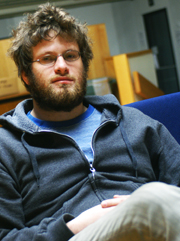The Quartz Cantabile

Vacuum tubes powered the amplification that guitar rock was built on.
Are Bunsen-burned test tubes about to fire up the next music revolution?
 |
"His focus was on solar heat. I decided to adapt that to a fully-tonal musical instrument, but I wanted to use an open flame rather than solar or electrical heat, mostly for aesthetic reasons," says Lerew.
Lerew's Div III, titled "The adaptation of basic thermoacoustic phenomena for a musical system", chronicles the steps he took to turn theory into a usable instrument. Understandably, it took plenty of hands-on experimentation before he hit on the right combination of glass, flame, and tone now known as the "quartz cantabile."
"It changed a lot since I started. I had no experience with making anything," he says, "so I ran into a lot of unforeseen difficulties. But I got a lot of help on the way."
That help included advice from Duffey, Hampshire Associate Professor of Physics Fred Wirth (Lerew's Div III chair), Lemelson machine shop manager Glenn Armitage, retired Amherst College professor Dan Krause and Tim Landers of the UMass Amherst scientific glass lab.
Lerew ended up building his quartz cantabile out of 25 test tubes, each a single pitch spanning a range of two chromatic octaves and strung horizontally in a metal framework above 15 Bunsen burners that can be moved around to play the tubes needed for a certain piece. Each tube has a small hole ground in the closed end that he covers to make it emit a sound, and contains a ceramic "stack," a piece taken from a catalytic converter, that facilitates the extreme temperature gradient required to initiate the sound.
"It's ten feet long, and it takes two or three people to play it properly," says Lerew, who performed on the quartz cantabile with fellow students Jeff Striker and Wilson Kemp for his Div III presentation. "It lends itself to slower, free form styles of music. It's extremely sensitive to atmospheric conditions, so when you sustain a chord it kind of phases in and out as the pitches slightly shift. The subtle changes are really what make it interesting and beautiful."
Lerew plans to explore the marketability of the quartz cantabile when he moves to the San Francisco Bay Area after graduation. He hopes to fine-tune the design and further his physical understanding of the instrument in coming months as well.

